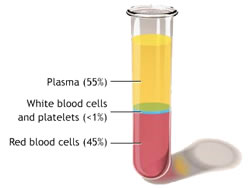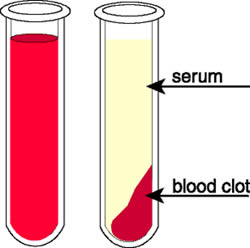Difference between Plasma and Serum
Key difference: Blood is a major component of the human body. Blood can be broken down in to three main categories: whole blood, plasma and white cells. Blood plasma, which makes up about 54.3% of the blood, is a fluid that is the blood's liquid medium. It is straw-yellow in color and essentially is used to transport the blood cells or corpuscles from one place to another within the body. The serum is essentially plasma from which the clotting proteins, i.e. the fibrinogens, have been removed. Hence, a serum is just plasma minus the clotting proteins.
 Blood is a major component of the human body, rather any animal body. In humans, blood accounts for 7% of the weight. An average adult has approximately 5 liters of blood, or 1.3 gal.
Blood is a major component of the human body, rather any animal body. In humans, blood accounts for 7% of the weight. An average adult has approximately 5 liters of blood, or 1.3 gal.
Everything about the human body is complex, so is blood. Blood is made up of various components. Blood can be broken down in to three main categories: whole blood, plasma and white cells. Whole blood accounts for 45% of the blood, the plasma for about 54.3%, and the white cells for about 0.7%.
Whole blood can be further broken down into individual substances. Whole blood contains several various kinds of cells, including erythrocytes, commonly known as red blood cells, leukocytes, also known as white blood cells, and thrombocytes, which are also called platelets. All these cells together are known as corpuscles or formed elements.
Blood plasma, which makes up about 54.3% of the blood, is a fluid that is the blood's liquid medium. There is approximately 2.7–3.0 liters (2.8–3.2 quarts) of blood plasma within an average human body. The liquid is essentially made up of 92% water, 8% blood plasma proteins, and trace amounts of other materials. It is straw-yellow in color and essentially is used to transport the blood cells or corpuscles from one place to another within the body.
Plasma plays an important roll in the body and that is to help circulate dissolved nutrients, such as glucose, amino acids, and fatty acids which are either dissolved in the blood or bound to plasma proteins. Plasma also helps removes waste products, such as carbon dioxide, urea, and lactic acid.
Other important components of plasma include serum albumin, blood-clotting factors to facilitate coagulation, immunoglobulins, which are also known as antibodies, lipoprotein particles, other proteins and various electrolytes such as sodium and chloride.
In order to separate plasma from the blood, a centrifuge is used. A centrifuge, essentially, spins the blood, which is in a test tube, until the heavier blood cells fall to the bottom of the tube. The lighter plasma collects to the top and then can be poured out in another container.
 The serum is essentially plasma from which the clotting proteins, i.e. the fibrinogens, have been removed. Hence, a serum is just plasma minus the clotting proteins. However, serum does contain all proteins not used in blood clotting, including electrolytes, antibodies, antigens, hormones, and any exogenous substances, such as drugs and/or microorganisms.
The serum is essentially plasma from which the clotting proteins, i.e. the fibrinogens, have been removed. Hence, a serum is just plasma minus the clotting proteins. However, serum does contain all proteins not used in blood clotting, including electrolytes, antibodies, antigens, hormones, and any exogenous substances, such as drugs and/or microorganisms.
The process of separating the serum is called plasmapheresis. Plasmapheresis is the medical therapy that involves blood plasma extraction, treatment, and reintegration. The study of serum is serology. Serum is often used in numerous diagnostic tests, as well as in blood typing.
Once, the plasma is separated from the blood by using a centrifuge, the anti-coagulated blood is allowed to coagulated or clot. The coagulated blood sinks to the bottom of the test tube, leaving the serum on top. In order to separate the plasma, an anticoagulant is usually added to the blood sample, which does not allow the blood to clot. However, to separate the serum the anticoagulant is not added, which allows the blood to clot and to remove the fibrinogen, i.e. clotting factors, from the serum.
Image Courtesy: drdigney.com, studyblue.com









Add new comment